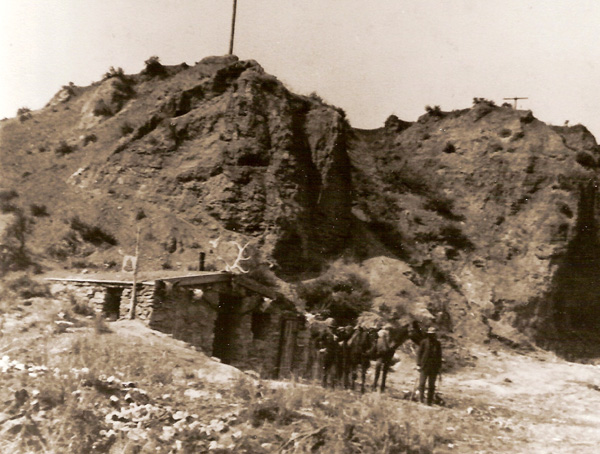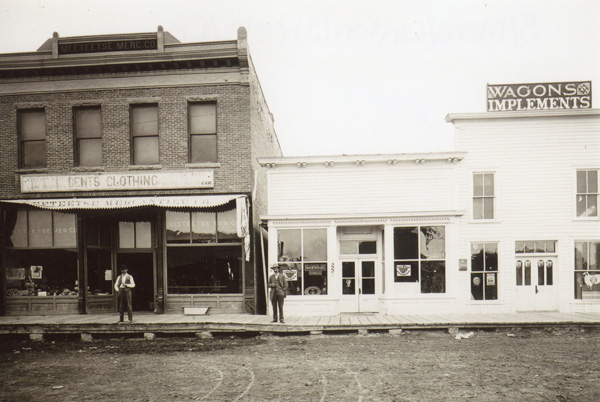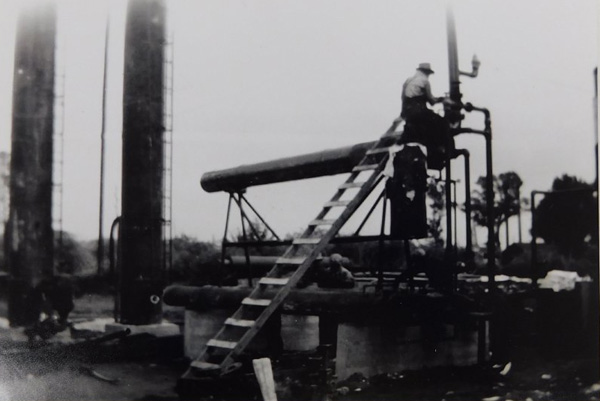Local Attractions
Local Attractions
The Masons in Meeteetse and Big Horn Basin needed a place to meet in order to form a lodge. They organized a stock company, the Meeteetse Hall Company, to raise the money for the building. It cost $6500 to build a two-story building 36 feet by 70 feet in 1900. Lumber was shipped from the West coast to Red Lodge, Montana, then to the nearest railroad to Meeteetse, and finally hauled to Meeteetse on wagon teams. At the time, the Cody Enterprise described it as “overlooking the town like the Parthenon at Athens.”
With a building, the Grand Lodge of Wyoming, AF & AM, issued the dispensation for the new lodge (Signet #18) and it was instituted in 1901, receiving its charter later the same year. When it was first organized, the lodge had jurisdiction over most of the Big Horn Basin, an area of about 14,000 square miles. It was the “mother lodge” for the area and helped create seven more lodges in the basin with 700 members in an area with a population of about 30,000. The Masonic Lodge officially purchased the building from the Hall Company in 1939.
The Masons weren’t the only groups using the building. In addition to the Masons meeting twice a month, the Order of the Eastern Star, the Rebekah Lodge, and the Modern Woodmen of America met twice monthly while the International Order of Odd Fellows met weekly, and the Improved Order of the Red Men (of America) sometimes met weekly and sometimes twice monthly.
The Hall also functioned as a type of community and social center. The school next door used its stage for programs and plays. There were dances there most Saturday nights and Robert Burns’ dances in February (beginning 1902 to WWII) as well as political rallies.
Due to lower membership numbers, the lodge merged with Cody in 1976 and the next year the Meeteetse Museums occupied the building as its Hall Museum. In 1986, the lodge granted a Quitclaim Deed to the Meeteetse Museums, Inc. for $1.00. The museum tried to get it on the National Register in 1990 but the building had had too many structural changes to qualify.
Problems between the county museum board and MMI in the early 2000s led the museum to move into the building with the Charles Belden Museum. In 2011, an auction of antiques was held at the hall by John Fremlin. Fremlin now owns the building and operates it as “Hole in the Wall Antiques”.
The very first town established in the Big Horn Basin (and perhaps the most violent) was Arland, Wyoming. Located up Meeteetse Creek about eight miles north of the present town of Meeteetse, Arland only existed for 13 years (1884 through 1897), but in that short time, developed its “wild and wooly” reputation. In those days, it was part of Fremont County and, at its height, had a population of between 50 and 75 very onery people.
The town of Arland was founded by French businessman Victor Arland and a buffalo hunter named John Corbett. Before its founding, the two men had previously operated a trading post on Trail Creek, as well as another on Cottonwood Creek, just north of present day Cody, Wyoming. However, with new cattle ranches, such as the Pitchfork, being established to the south, Arland and Corbett moved their operations into that area and established “Arland.” Serving as a stage stop and supply station for nearby ranchers, Arland grew rapidly and had a post office, store, and saloon (which were in one building), a dance hall, rooming house, restaurant, blacksmith shop, livery stables, cabins, and corrals. Victor Arland ran the saloon. Among its residents were cowboys, settlers, and even prostitutes. The most famous of the latter were Belle Drewry (known as the “Lady in Blue”) and Rose Williams, the proprietor of the town’s bordello.
Arland was an isolated community and far from the law. The nearest sheriff was located 150 miles away in Lander. This gave free reign to lawlessness, including numerous murders. In 1888, for example, Victor Arland shot and killed “Broken Nose” Jackson in self-defense at a dance in town. Both men had romantic designs on Rose Williams, who operated Arland’s bordello. Allegedly in revenge for this killing, Victor Arland was shot and killed through an open window as he sat at a poker table at a saloon in Red Lodge, Montana. The town experienced other revenge killings, as well. William Gallagher, who was a cowboy for the Pitchfork Ranch, brutally beat Belle Drewry, who had been his lover, but had “taken up” with Bill Wheaton. An outraged Wheaton shot Gallagher between the eyes. In response, Gallagher's best friend, Blind Bill Hoolihan, said that he was going to kill Wheaton. Wheaton, however, got wind of Hoolihan's plan and shot him first! Even Belle Drewry, the prostitute, killed someone. One night in 1897, Drewry got into a dispute with a cowboy and shot him dead. The dead cowboy’s friends returned the next night, killing Drewry and three other women.
Like many of its ill-fated residents, Arland did not have long to live. After a new bridge was built over the Greybull River at the new town of Meeteetse, commerce bypassed Arland. Almost overnight, its businesses dried up. Buildings were dismantled and many were moved to Meeteetse and repurposed. The building that housed Arland’s hotel, for example, was moved to Meeteetse and again served as a hotel at the corner of Park and State Streets. By 1897, Arland was no more.
Today nothing remains of the town - no buildings, no foundations, nothing but the stories of violence and murders. Even visiting the site is prohibited, as it is located on private property. To learn more about historic Arland, visit the following sites:
One of Meeteetse’s most iconic buildings is the Barling Garage. Located on State Street, this historic structure is a favorite of tourists and other casual photographers! W. E. (William or Bill) Barling opened the business in 1924 and expanded it four years later, incorporating Barling Construction. The Barling Garage and Barling Office sit side-by-side.
Both businesses were instrumental to Meeteetse’s growth during the 1920s and throughout the mid-century. Barling Construction worked on many different projects in Meeteetse. These included making road improvements, paving the downtown streets, and adding curbs and gutters. The company even built skating rinks! The Garage maintained the vehicles and equipment, not only later for its construction arm, but for all those in the area who needed mechanical help. Lloyd Barling helped his father, Bill, run the business for many years. Lloyd retired in 1979 and, at that time, both the Barling Garage and Barling Construction closed.
Tourists love peeking through the front plate-glass windows where they see the Garage just as it was in 1979 when Lloyd Barling retired. If you pass through Meeteetse, be sure to stop and take a few pictures of this important structure from the early days of our town.
The first post office was Otto Franc’s on the Pitchfork Ranch, with mail delivery primarily by Josh Deane. Otto later convinced Mrs. Wilson to run the post office in Old Meeteetse (across the Greybull near Meeteetse Creek). In 1896, Mrs. Wilson moved it across the Greybull into the township being organized as Meeteetse. The post office was located in various buildings and their owners became the postmasters. The Lawler Gas station and Young Garage may have housed the first post offices in Meeteetse.
The site of the Old Post Office (the first built solely as a post office) is on the corner of Water Avenue and State Street. Postmasters like Allen T Frans (Postmaster 1929 to 1958) lived in the back and the front was the post office. Hazel Bennion was the postmaster when the new post office was built in its current location on Park Ave and dedicated in February 1962; Hazel had started in Aug 1951 under Postmaster Frans. This new building had a “modern look” and used “modern materials” as part of JFK’s modernization of the postal department, including a commercial leasing plan.
Lucille’s Café opened in the Old Post Office in 1977 by Lucille Hogg (of black-footed ferret fame). She later added the Ferret Diner (Ferret Den) to the right of the original post office structure. When Lucille died in 2002, her daughters Emily Coale and Julie Sax took it over with cook Rita Farmer and waitress Ruby Moore. Lucille’s closed in 2013 after Emily began having health problems.
The Meeteetse Conservation District had rented offices in the old town hall building but the town sold the building circa 2013 to the fire department. The MCD considered building their own space (and even put out bids) but decided to purchase the former Lucille’s Café in the fall of 2014. The Ferret Den banquet room would be turned into a conference room that could be used by the public. Today, the Ferret Den frequently houses craft venders during town celebrations like Labor Day, Ferret Day, and Christmas in Meeteetse.
Guy Curtis built and opened the Elkhorn Bar and Lounge in the 1940s and ran it with his son Ronald.
Joe and Alice Kordonowy bought it in 1994, probably from Ronald’s family since he died that year. During their 21-year ownership, it was a popular place which unfortunately was the scene of a shooting in 1997. A man on meth broke in one night and the older couple defended themselves with a gun; the man died after leaving the bar. The couple had had health problems, believed themselves in danger, and thus were not charged.
David Ozburn and his wife Marline purchased it in 2015. Unfortunately, a year later, Ozburn committed suicide.
It continues as a popular place under the current owners, Magnum and Rachel Faust, who bought it in January 2017. The restaurant and bar is open six days a week and serves delicious food. More information can be found on their Facebook page.
 The trip from Meeteetse to Cody was not a quick or easy one before automobiles. Horses pulling stage coaches full of mail and people needed water, rest, and feed. In addition, stage passengers on the rugged and often icy or muddy roads just needed a break from all the hard bouncing. The Halfway House Stage Stop filled this need. This stop was located halfway between the Meeteetse Bridge over the Greybull River and the Corbett Crossing on the Shoshone River toward the northeast (about 15 miles north of Meeteetse on State Highway 120).
The trip from Meeteetse to Cody was not a quick or easy one before automobiles. Horses pulling stage coaches full of mail and people needed water, rest, and feed. In addition, stage passengers on the rugged and often icy or muddy roads just needed a break from all the hard bouncing. The Halfway House Stage Stop filled this need. This stop was located halfway between the Meeteetse Bridge over the Greybull River and the Corbett Crossing on the Shoshone River toward the northeast (about 15 miles north of Meeteetse on State Highway 120).
The Stage Stop, itself, was constructed in 1904 by brothers Charles and George Wilson, who had earlier constructed the Cody to Meeteetse Road. It consisted of a primitive rock dugout that the two built into the side of a hill. It can be assumed that primitive outhouses existed, as well. The station advertised both telephone service and also sold “delicious pies” to hungry travelers. Most importantly, it was a place where the Concord stage coaches could change their tired horses for fresh ones.
The station only operated for four years and was abandoned in 1908 after automobiles began to use the route. The spring, however, continued to be a favorite watering place for travelers for many years. A historic marker on State Highway 120 marks the location of the stage stop and commemorates early station keepers, such as Miles Bennett (the first keeper at the Halfway House Stage Stop), and travelers who passed through. Unfortunately, no historic structures survive.
The Blue Ribbon Bar was located where the Meeteetse Chocolatier is today. Its original owner was Al McGuire. Before opening Al McGuire’s Place which then became the Blue Ribbon Bar, McGuire owned several bars in town and was a member of the town council. The Blue Ribbon Bar, which later changed its name to the Blue Ribbon Café and Lounge, was in operation for roughly sixty years. The bar from the Blue Ribbon Bar and some other staples can be seen in the Meeteetse Mercantile exhibit at the museum. Today, the building is occupied by the famous Meeteetse Chocolatier.

The Meeteetse Mercantile was opened in April 1899 when Angus J. “A.J.” McDonald bought a millinery store and transformed it into a general store. General stores carried everything the local community needed including dry goods, clothing, and ranching equipment. In 1917, L.G. Phelps bought “the Merc” from A.J. McDonald. The Phelps descendants were represented in the business until 1999 when the Merc closed briefly and came under new ownership.
Today, the southern portion of the Merc is the studio of sculptor Vic Payne and artist Jordyn Payne. Their work can be viewed at www.vicpaynestudio.com and www.jordynpaynefineart.com. The other side of the Merc is a coffee shop and ice cream bar, Bronco Nell’s. The shop is named after freighter, Ella “Bronco Nell” Smith. One of the early Meeteetseans, Bronco Nell hauled freight from Red Lodge to Meeteetse, Meeteetse to Cody, and even hauled mining equipment and supplies to the mining town of Kirwin. She was also the last woman to serve time at the Wyoming State Penitentiary in Rawlins.

The oil industry has played a significant role in the Meeteetse-area since the early 1900s. Activity in northwest Wyoming first exploded after geologist Thomas Harrison discovered the Oregon Basin Field north of Meeteetse in 1908. Making the Salon Wiley Ranch his headquarters, Harrison and Wiley teamed up with the oil company ENALPAC to find commercial quantities of oil. It was a struggle early on, as Harrison and ENALPAC kept hitting natural gas, which was unmarketable in those days. Although ENALPAC eventually found oil and gained control of the field, the history of Oregon Basin would ultimately be written by another group, the Ohio Oil Company. It was the Ohio, led by James Donnell, that entered the Wyoming scene in 1921, solved the natural gas issues, and made Oregon Basin the productive field it is today.
Other discoveries in the Meeteetse area soon followed. Companies, large and small, began prospecting at Grass Creek (1912), Little Buffalo Basin (1914), Hamilton Dome (1918), Sunshine North (1921) and the Pitchfork field (1928). Two companies, however, dominated in Wyoming during these early years: John D. Rockefeller’s Standard Oil and Donnell’s Ohio. It was the ability of these companies to solve Wyoming’s transportation, market, and low price issues that propelled them ahead of other producers in the state. Keys to their success were their overall financial strength and the creation of pipelines that transported their oil to railheads, then to refineries. The Ohio was the most successful of all companies operating in northwestern Wyoming. It was also innovative, as it was one of the first to build housing and services for its employees. This innovation at Grass Creek physically kept employees on the work site, making for a stable work force. Under Donnell’s leadership, the Ohio experienced enormous growth and entered the areas of retail sales and refining as early as the 1920s. The Ohio later became Marathon Oil, which remained in Wyoming for a century.
Over the decades, energy companies, such as Husky and Marathon provided many jobs for area workers. Today, visitors can drive through the major fields, but are discouraged from visiting rigs and other installations due to dangers posed. To learn more about the oilfields of Wyoming, view the following interactive map:
The Shoshone National Forest is the first federally protected National Forest in the United States. It encompasses nearly 2,500,000 acres and is filled with native animal and plant species including one of the largest herds of bighorn sheep in the United States. Though named after the Shoshone tribe, other Native American groups used the area including the Lakota, Crow, and Northern Cheyenne. Archaeological finds indicate that the region has a 10,000 year history.
The first Euro-American to explore the region was John Colter who visited between 1807 and 1808. After his visit to the area, U.S. President Theodore Roosevelt included it in the Yellowstone Timberland Reserve in 1891. When the U.S. Forest Service was created in 1905, the land became a National Forest.
Today the Shoshone National Forest offers recreational opportunities from hiking, camping and cross country skiing through the Meeteetse Recreation District. The national forest also includes historic sites such as the mining town of Kirwin, historic Double Dee guest ranch, and Anderson Lodge.
Kirwin
Kirwin was established after Bill Kirwin and Harry Adams discovered gold on a hunting trip in 1885. There were high hopes for the prosperity of Kirwin. Rumors spread throughout the West of the rich gold and silver deposits on the mountain. At its peak Kirwin had 200 residents and 38 buildings. A telephone line was built to the town and the stage ran from Meeteetse to Kirwin every other day. Unfortunately, the rumors of riches were largely unfounded. In 1907 an avalanche crashed into the town killing three people and destroying several buildings. The avalanche signaled the beginning of the end of the mining town. The town of Kirwin was included in Carl Dunrud’s purchase of the Double Dee Guest Ranch. It was later sold to American Metal Climax, Inc. (AMAX).
Double Dee Guest Ranch
The Double Dee Ranch was owned and operated by Carl Dunrud from 1931 until 1945. Guest ranches like the Double Dee offered “dudes” from the city to experience the Western way of life. The Double Dee offered hunting, fishing, hiking, horseback riding, and more in the scenic Absaroka Mountains. Guests to the ranch included author, Hubbard Hutchinson; illustrator, Wallace Smith; and pilot, Amelia Earhart. After Carl Dunrud, subsequent owners included Basil Bennett, Duke Wilson, and AMAX.
Anderson Lodge
Artist Abraham Archibald (A.A.) Anderson visited the Rocky Mountains on a tour of the American West in 1883. At the time he was living in Paris, learning from French painters. He fell in love with the rugged West and made a claim of 160 acres on the Greybull River. Anderson called this claim the Palette Ranch.
This claim now sits on the Shoshone National Forest, 40 miles west of Meeteetse. The Palette Ranch has been a vital part of Shoshone National Forest creation and history. In the spring after filing his claim on the land, Anderson returned and found it overgrazed by the cattle of neighboring ranchers. Furthermore, the mountains had been burned which Anderson was convinced was the product of overgrazing by sheep. After putting up the first barbed wire fence in the Bighorn Basin, Anderson began a campaign to stop overgrazing. In 1901, Anderson invited President Theodore Roosevelt to his ranch and spoke to him about more intensive management policies for the Yellowstone Timberland Reserve. One year later, Roosevelt appointed Anderson as Special Superintendent of Forest Reserves, a position Anderson held until the duties were transferred to the Forest Service in 1906. During his time as Superintendent, Anderson used the Palette Ranch as his headquarters.
One of the most distinctive buildings of the Palette Ranch is known as Anderson Lodge. The Lodge was built in 1890 as an artist’s studio and hunting lodge. Six miles west of the main headquarters of the ranch, the two story cabin was fitted with copper hot wire indoor plumbing. The cabin was listed on the National Register of Historic Places in 1987 for its association with the national conservation movement, its association with A.A. Anderson, and distinctive architecture and use.
For more information .
Address
PHYSICAL ADDRESS
1947 State Street
Meeteetse, Wyoming 82433
MAILING ADDRESS
PO Box 248
Meeteetse, Wyoming 82433
Hours
Hours: Tues through Sat 10 AM – 4 PM
Meeteetse Museum © 2025 All Rights Reserved

